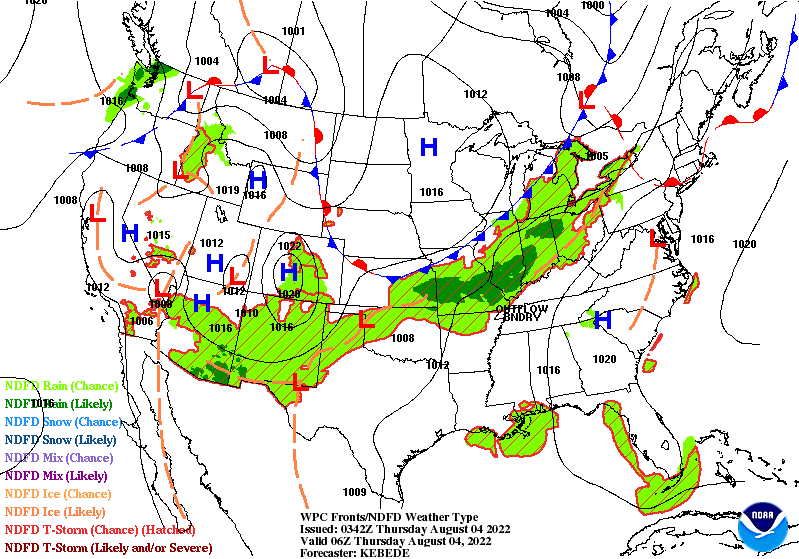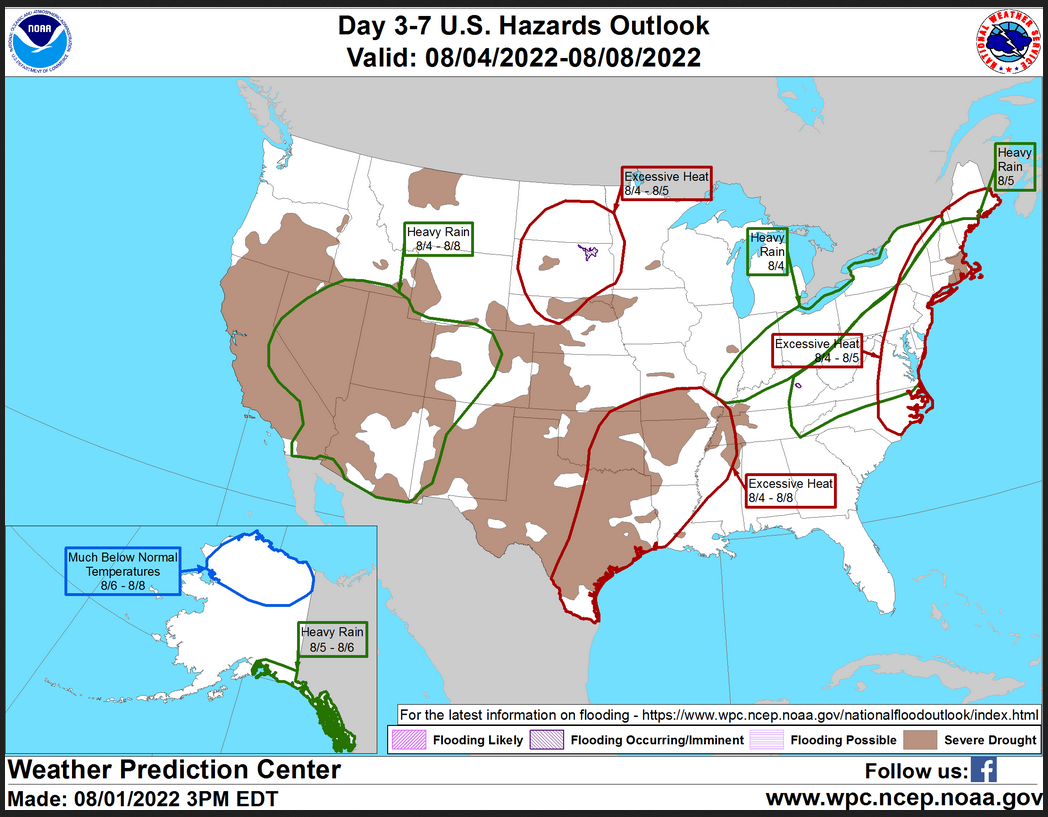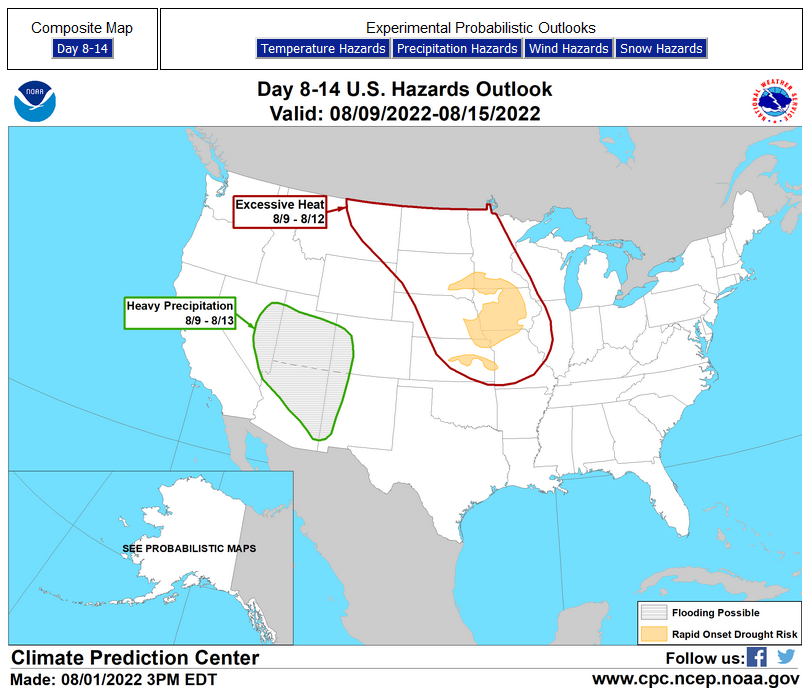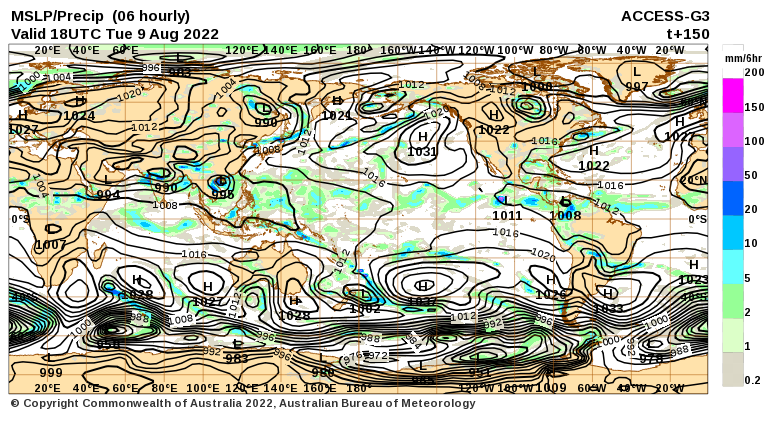Here is what we are paying attention to this evening and the next 48 hours from this evening’s NWS Forecast.
...Monsoonal rains across the Southwest is forecast to expand northward by Friday as heavy rain and possibly severe thunderstorms move across the Great Lakes/Midwest through tonight... ...Heat is expected to build across the northern Plains and the Northeast for the next couple of days... ...Fire Weather Threat to continue from the Northwest into the northern High Plains..
Continuation of the NWS Short Range Forecast (It is updated twice a day and these updates can be found here.
A cool upper trough moving into the Pacific Northwest will gradually spread cooler than normal temperatures further inland, bringing an end to the recent heat wave across the region. In contrast, southerly flow and downslope winds will bring a brief heat wave across the northern Plains for the next couple of days before the cooler air arrives behind a cold front. The Northeast will see heat building across the region as high temperatures are forecast to reach 95-100 degrees Thursday afternoon followed by another hot afternoon on Friday but with the arrival of showers and thunderstorms. Meanwhile, triple-digit heat will remain the rule over the central U.S. through the end of the week under a deep layer upper level ridge with generally sinking air and mostly sunny skies. Therefore, heat advisories are in effect from central Texas to the southern Great Lakes and Ohio Valley. Heat advisories are also in effect for parts of the Northeast into the Mid-Atlantic where higher humidity could result in heat indices soaring well above 100 degrees on Thursday and Friday afternoons. In terms of rainfall prospects, moisture will continue to linger in place across much of the Intermountain West as well as the Desert Southwest through the end of the week, with the heaviest rainfall expected across the Sierra Nevada, the Front Range of the Rockies, and southeastern Arizona. An area of organized heavy showers and storms is forecast across the mid-Mississippi Valley to the Midwest tonight and into Thursday ahead of a cold front, with some potential of 1-3 inch rainfall totals and localized flooding. Meanwhile, severe thunderstorms across the Great Lakes should become less active by Thursday as they move farther south into the Mid-Mississippi and Ohio Valleys. Fire weather concerns will also continue to make headlines across much of the interior northwestern U.S. and extending eastward across Montana. A combination of gusty winds and low humidities will increase the potential for wildfires, and some high-based thunderstorms with limited rainfall and cloud-to-ground lightning may also be cause for concern into Thursday. By Friday, increasing moisture drawn northward from the monsoonal moisture in the Southwest will lead to increasing rain chances across the northern Rockies as a cold front edges in from the north and becomes nearly stationary.
Maps that relate the forecast to geography can be found by clicking Here for Day 1 and Here for Day 2.
Here is a 60-hour animated forecast map that shows how the short-term forecast is expected to play out.
If it needs to be updated click here.
HAZARDS OUTLOOKS
Click here for the latest complete Day 3 -7 Hazards forecast which updates only on weekdays. Once a week probably Monday or Tuesday I will update the images. I provided the link for readers to get daily updates on weekdays. Use your own judgment to decide if you need to update these images.
Worldwide Tropical Forecast
(This graphic updates on Tuesdays) If it has not been updated, you can get the update by clicking here
Detailed Maps and Reports for the Western Atlantic and the Pacific Oceans
Below are three maps that summarize the situation for the Atlantic, Eastern and Central Pacific. Additional information can be accessed by clicking HERE
First the Atlantic
Click to view the forecast map and have access to additional information https://www.nhc.noaa.gov/gtwo.php?basin=atlc&fdays=5
Then Eastern Pacific
Click to view the forecast map and have access to additional information https://www.nhc.noaa.gov/gtwo.php?basin=epac&fdays=5
Then Central Pacific
Click to view the forecast map and have access to additional information https://www.nhc.noaa.gov/gtwo.php?basin=cpac&fdays=5
And the Western Pacific
Click to view the forecast map and have access to additional information https://www.metoc.navy.mil/jtwc/jtwc.html
Some Intermediate-Term Outlooks
Links to “Outlook” maps and discussions for three time periods. Days 6 – 10, Days 8 – 14, and Weeks 3 and 4. An outlook differs from a forecast based on how NOAA uses these terms in that an “outlook” presents information from deviation from normal and the likelihood of these deviations.
You have to click on the links because they do not update automatically and I do not want to have stale images in the article. But it is not difficult to click on a link and you get a large image plus a discussion. On Fridays in a separate article, we will show the images and provide a link in this article that article. But remember what you will see is the images as of Friday. But here you can get the current images simply by clicking on them. Then hit the return arrow at the upper left of your screen to return to the article. You will not find this information easily anywhere else.
Right now you can find these maps here (We show them every Friday there but you can click above and find them).
World Forecast for Day 6 (Currently Set for Day 6 but the reader can change that)
World Weather Forecast produced by the Australian Bureau of Meteorology. Unfortunately, I do not know how to extract the control panel and embed it into my report so that you could use the tool within my report. But if you visit it Click Here and you will be able to use the tool to view temperature or many other things for THE WORLD. It can forecast out for a week. Pretty cool. Return to this report by using the “Back Arrow” usually found top left corner of your screen to the left of the URL Box. It may require hitting it a few times depending on how deep you are into the BOM tool. Below are the current worldwide precipitation and air pressure forecasts for six days out. They will not auto-update and right now are current for Day 6. If you want the forecast for a different day Click Here I will try to update this map each day but you have the link so you can access the dashboard and get a wide variety of forecasts.
I mostly rely on the reader to interpret world maps. For this map, areas of expected precipitation for the date and time shown are clearly shown.
The number of High-Pressure systems shown is called the Wave Number. Maybe I will discuss WN someday. But it shows how many Rossby Waves there are around the World. Sometimes they are hard to count. Counting Low-Pressure systems should provide the same WN. Rossby Waves are the way the temperature distribution of the Planet remains in balance. It is basically the science of fluid dynamics. It can be very helpful in predicting the movement of weather patterns.
Month to Date Information
Month to date Temperature can be found at https://hprcc.unl.edu/products/maps/acis/MonthTDeptUS.png
Month to date Precipitation can be found at https://hprcc.unl.e d u/products/maps/acis/MonthPNormUS.png






